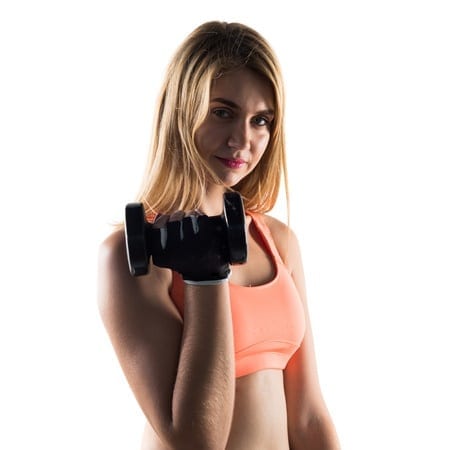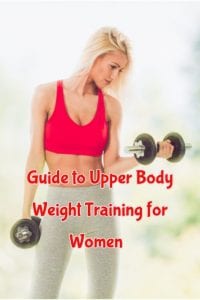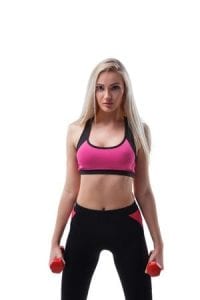 This article discusses upper body weight training for women and why you should include it in your workouts if you want your body to be strong and balanced.
This article discusses upper body weight training for women and why you should include it in your workouts if you want your body to be strong and balanced.
The focus of many exercise programs for women is the buttocks, hips, and thighs, as these are the areas where we tend to accumulate excess fat.
In our twenties and thirties, we may get away with not exercising our upper body. However, once we hit our forties and fifties, our arms and the triceps muscles, in particular, start to lose muscle tone and sag. Over time, the laxity becomes even more apparent.
Once the muscle tone has gone, the only way to get it back is to do regular strength training sessions. This will be the case whatever your weight.
Some women are so embarrassed by the appearance of their upper arms that they cover them on even the hottest days.
But with a bit of effort, you will be able to wear sleeveless and short-sleeved tops again. And there’s no need to be concerned that weight training will over-develop your muscles and make you look like a man!
Female hormones are different from those of males. The female weightlifters you’ve seen with very bulky muscles train with heavy weights and follow an extremely stringent diet. Some also take anabolic steroids.
Next, we will cover the main benefits of upper body weight training for women.
Table of Contents
The Benefits of Upper Body Weight Training for Women
An upper body weight training program undertaken regularly will strengthen and tone your arms, chest, shoulders, and upper back, so you will look great wearing halter necks, strapless, and backless tops.
wearing halter necks, strapless, and backless tops.
With a toned and sculpted upper body, your waist and hips will look smaller too.
Aesthetics aside, upper body weight training for women provides other benefits. Exercising your upper body will help you avoid postural problems that can lead to back pain.
It can also prevent you from getting a hunched neck and drooping shoulders that will make you look years older.
Known as kyphosis, this usually occurs due to muscle atrophy and the strength in the back, chest, and shoulders diminishing due to a lack of use. This continues to worsen with advancing years.
Whatever your age, with regular exercise, you can improve the appearance of your upper body.
Your arms may not regain the tone they had when you were younger. However, when you build muscle, your skin will stretch over the muscle rather than hang down, so there will be less slack.
If you are overweight, you will need to cut calories and do cardio to lose weight for your arms to look their best.
A strong upper body will also make it easier to do household chores, tote groceries when shopping at the supermarket, and lift and carry your child or grandchild.
Keep reading for a list of upper body weight training exercises, the muscles they target, and what weight to use.
Exercises to Try
Following is a list of upper body weight training exercises, the primary muscles they target, and the equipment requirement in brackets. None require using a home gym, but most use dumbbells or a barbell
When formulating your upper body weight training program, include at least three or four of the exercises in every routine. By doing this and varying the exercises, you will work your entire upper body.
Some of the exercises require equipment.
The weight you use will depend on the exercise, with most women finding that 2lb, 5lb, and 8lb weights work well to start. As your strength and fitness improve, you can work with slightly heavier weights.
Work out on non-consecutive days. Aim for 8 to 10 reps of each exercise, and build up to doing 3 sets, maintaining correct form.
If you struggle to do 8 reps, use a lighter weight. Work with a heavier weight if you can do 10 reps easily.
If you don’t know how to do the exercises, Google them, or search for video demonstrations on YouTube.
Standard, Incline, and Decline Push-Ups –
Push-Ups work the chest, arms, shoulders, back, triceps, and neck. You won’t need any equipment to do Standard Push-Ups. Incline and Decline Push-ups require a low, sturdy bench or a Step.
Tricep Dips –
Tricep Dips target the chest, arms – especially the triceps – shoulders, and back muscles. (A bench or sturdy armless chair)
Pull-Ups and Chin-Ups –
Pul-Ups and Chin-Ups work the lats and the biceps. (A fixed bar or a sturdy tree branch)
Barbell Chest Presses –
Barbell Chest Presses work the chest, triceps, shoulders, scapulae, and back. (A barbell)
Upright and Bent Over Rows –
Upright and Bent Over Rows work the back, shoulders, and biceps. (A barbell)
Back Rows –
Back Rows work the biceps, lower lats, lower back, and rear deltoids. (A barbell)
Shoulder Shrugs –
Shoulder Shrugs target the shoulders and back. (Dumbbells)
Bicep and Tricep Curls –
Bicep and Tricep Curls work the biceps and triceps. (Dumbbells)
Hammer Curls –
Hammer Curls work the forearms, biceps, anterior deltoids, upper, and middle back. (Dumbbells)
Dumbbell Chest Flyes –
Dumbbell Chest Flyes target the chest, shoulders, and biceps. (Dumbbells)
Dumbbell Chest Presses –
Dumbbell Chest Presses work the chest, front of shoulders, biceps. (Dumbbells)
Front and Lateral Raises –
Front and Lateral Raises target the shoulders, chest, lateral deltoids, middle and lower back, and serratus anterior. (Dumbbells)
Upper Body Weight Training for Women Summary
Done regularly, the upper body weight training exercises above will quickly tone your muscles and improve your strength.
If you’d like more variety,  search online, and you will find plenty of other upper body exercises, including many that don’t require weights.
search online, and you will find plenty of other upper body exercises, including many that don’t require weights.
Another option is to use a fitness aid such as the Iron Gym Total Body Workout Bar, which targets the entire upper body. You can also use it to sculpt and strengthen your abs, so you’re essentially getting two devices for the price of one.
Whatever you choose to do, consistency and progressive overload are the keys to getting good results. Devise an upper body weight training program and stick with it. Ten to fifteen minutes three or four times a week is all the time you need.
Record your sessions in a journal, including which exercises you did, how many reps, your rest intervals, and your training duration. You can also record how easy or difficult they were. This will give you an accurate idea of your progress and let you know when it’s time to increase the weight you’re working with or add additional reps.
You may also like to read Calisthenics Leg Workout – How to Build Muscle Without Weights.

